 | |
Dyslexia | ||
According to Dictionary.com, dyslexia is "any of various reading disorders associated with impairment of the ability to interpret spatial relationships or to integrate auditory and visual information." [1] According to the International Dyslexia Association (IDA), Dyslexia is a specific learning disability that is neurobiological in origin. It is characterized by difficulties with accurate and/or fluent word recognition and by poor spelling and decoding abilities. These difficulties typically result from a deficit in the phonological component of language that is often unexpected in relation to other cognitive abilities and the provision of effective classroom instruction. Secondary consequences may include problems in reading comprehension and reduced reading experience that can impede growth of vocabulary and background knowledge. Many reading difficulties can be confused for dyslexia and have similar symptoms. True organic dyslexia will show in differences in a brain scan and will take extensive remediation. However, sight word teaching, phonemic awareness difficulties, or specialized vision problems can also cause reading difficulty and are often mistaken for true organic dyslexia. These first three difficulties are much easier to remediate than true dyslexia and should be screened out and remediated before beginning a program specifically designed for a student with true dyslexia. 40L volunteers have remediated hundreds of students over the last 20+ years and the majority of these students did not have true dyslexia, but instead were suffering from problems caused by poor teaching methods such as sight words and other whole language practices. A few additional students had phonemic awareness, speech/language processing problems, or specialized vision problems. Remediation for any of these problems is much quicker than remediation for dyslexia, and are listed in the order they commonly occur. More information about each of these reading problems and information about true dyslexia and its remediation are below the chart. | |
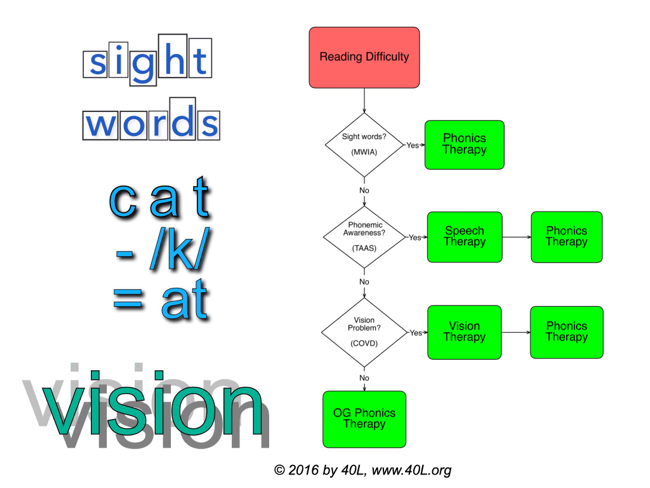 | |
Sight Words Poor teaching methods such as sight words can cause reading difficulties that mimic dyslexia. Sight words do not promote left to right reading because when memorizing words as a whole, the eye jumps all around the word. [2] Moreover, pictures and words are processed on different sides of the brain. Not only do sight words encourage incorrect eye movements, they also confuse the brain, which research has shown reads words sound by sound. Recent brain research has found that the adult brain of good readers does not process words as wholes, but instead, as Stanislas Dehaene explains in his article, The Massive Impact of Literacy on the Brain, by analyzing the individual letters and letter teams at the same time in a "massively parallel architecture." [3] The speed of this parallel processing led early researchers to believe that the brain was processing the words as a whole, but recent brain research using more powerful technology has found the opposite. According to Dr. Robert Myers of the Child Development Institute in his web page about Dyslexia & Reading Problems, "Children who have an average or above IQ and are reading 1 1/2 grades or more below grade level may be dyslexic. True dyslexia affects about 3 to 6 percent of the population yet in some parts of the country up to 50% of the students are not reading at grade level. This means that the reason for most children not reading at grade level is ineffective reading instruction. The dyslexic child often suffers from having a specific learning disability as well as being exposed to ineffective instruction." Dr. Reid Lyon, in his article "Reading Disabilities: Why Do Some Children Have Difficulty Learning to Read? What Can Be Done About It?" talks about phonics training and the prevention of reading failure through proper training: On the other hand, the early identification of children at-risk for reading failure coupled with the provision of comprehensive early reading interventions can reduce the percentage of children reading below the basic level in the fourth grade (i.e., 38%) to six percent or less.... These studies strongly suggest that such programs [systematic phonics] if implemented appropriately, could reduce the number of children who fail to learn to read well below the 38 % rate currently observed nationally. [4] In France, it was proven that schools that taught with phonics produced less dyslexic students than schools that taught with whole word methods. Acording to Geraldine E. Rodgers, However, the true sight-word method was generally discredited in Europe by the 1970's. Change was brought about by such things as those reported in a 1950 Enfance article. In France, 2% of dyslexic children were discovered in schools that used the phonics approach, but 20% of dyslexic children were discovered in schools that used the global [whole word] approach. [5] This article, available online from Don Potter's Education Page, also explains how teaching methods can cause dyslexia symptoms: Can Dyslexia Be Artifically Induced in School? A later article about Edward Miller's findings explains how for many students, dyslexia can actually worsen over the years due to repeated exposure to sight words. The Miller Word Identification Assessment (MWIA) can determine if dyslexia is organic or caused by poor teaching methods. A MWIA score with a slowdown shows dyslexia caused by whole word teaching, or poor phonics teaching that incorporates too many sight words. They will also generally miss more phonetic words than holistic words. A student with an organic reading disorder will have trouble reading both sections, but should normally read the holistic section slower than the phonetic section, and will have no slowdown or a negative slowdown score. A student who has been taught with a good phonics program with few sight words should not miss more than one word on each section and should read both parts at the same speed. However, a student with organic dyslexia who has been exposed to repeated sight words may also exhibit a slowdown on the MWIA. For students with organic dyslexia, a copy of "The Complete Handbook of Children's Reading Disorders" by Dr. Hilde L. Mosse is highly recommended. Dr. Hilde L. Mosse explains how whole word teaching can mimic several different organic reading disorders: Children who have not been taught to read and write phonetically--that is, by learning the sounds of letters and letter combinations--may have the same symptom [Word Blindness]. The word-picture or sight-word method of teaching beginners to read may cause a form of Word Blindness (Diak, 1960.) [6] Many of these mistaught youths [those taught with sight words] sweep their gaze around each word in a desperate effort to deduce its sounds and meaning from its contour. We know that patients with brain pathology who knew how to read before their disorder started, use this same technique as an aid to reading. Neurologists call this symptom "Westphal's Maneuver" after the neurologist who described it first (Critchley, 1970, p.3). It is a shame that a technique used with little success by desperate patients is taught to healthy children as part of the "sight word" method, where it is called a "configuration clue." When we observe a child doing this, therefore, we cannot assume that it necessarily indicates an organic reading disorder; it may be due to faulty conditioning. [7] The overwhelming majority of children with Linear Dyslexia have no organic central nervous system defects. As with most other reading disorder symptoms, defective linear reading is not specific for an organic causation of the reading disorder. Extensive studies show that this condition occurs most frequently as a result of faulty reading habits acquired at an early age. Non-organic factors that cause these faulty reading habits leading to Linear Dyslexia are whole-word teaching techniques, which I have already described, and early and excessive comic book reading. [8] Don Potter's Blend Phonics Reader presents words of similar configuration together to help dyslexic students overcome the problem of reading by configuration instead of properly sounding out the words from left to right. While whole word teaching is especially damaging, problems can also develop in students taught in a phonics program with too many sight words. Either of these teaching practices discourages reading from left to right. Dr. Hilde L. Mosse explains how current teaching methods can cause linear dyslexia: Foremost among these harmful teaching methods is the whole-word and word/sight technique. Daniels and I have observed the eye movements of children as they were learning to read by this method: In the beginning they are apt to look at a few words; then they look up at the picture searching for a clue, then down at the words again. They look back and forth along the line or the page for a familiar word (Mosse & Daniels, 1959, p. 838). This indicates that the method contains some of the same potentially harmful features we have already pointed out in comic books. The children are taught to look for what are called "pictures clues" and "content clues." They thus remain dependent on pictures much longer than they should and do not get used to linear reading from the very beginning.... The conventional teaching of phonetics in the later grades does not further linear reading either. Not only the first consonant but also the last is stressed when word reading is taught phonetically. This forces the children to look at the last part of the word first in order to figure out the last consonant. The linear left-to-right direction of a word is thus destroyed. [9] Phonemic Awareness Problems with reading can also be caused by difficulty with phonemic awareness. If you cannot hear the individual speech sounds in words and understand how to break them apart and put them back together to make words, it is difficult to learn to read, and this difficulty must be remediated before phonics remediation can be started. Interestingly, however, this skill must be explicitly taught, but some children learn it with little instruction at home or in school so it can seem to be a natural developmental process. As Stanislas Dehaene explains in a study of Portuguese adult volunteers, "Illiterates systematically failed whenever a game required attention to the phoneme level." [10] In his article "Literate to Illiterate," Dahaene explores brain changes that occur after learning to read. He states, "Literacy also modifies phonological coding and strengthens the functional and anatomical link between phonemic and graphemic representations." [11] A free phonemic awareness test is available from Spelfabet. It is called the Test of Auditory Analysis Skills, or TAAS. Students who have just a bit of a phonemic awareness problem can be helped with simple explanations of how speech sounds are made and how they combine, but more extensive remediation often requires a speech therapist. Several parents I have know have successfully done phonemic awareness remediation on their own with a program such as LiPS, Lindamood Phoneme Sequencing Program, but it requires a bit of study and work. Once phonemic awareness remediation is complete, you can begin phonics remediation. You may be able to begin phonics work after the first few steps of phonemic awareness are complete, and you can work on spelling rules and spelling simple words until phonemic awareness is developed enough to support blending sounds. Start with the easiest sounds to blend, vowels and m and n, making words such as "on, in, no, mom," and simple 2 letter syllables with these letters. Vision Problems There are vision problems that mimic the symptoms of dyslexia that can only be found by screening with a special type of vision doctor called a Developmental Optometrist. You can locate one of these doctors at their website, www.covd.org. They have a survey that you can use to see if vision problems may be the cause of reading problems. The vision therapy provided by these doctors has helped several of 40L's remedial students. The therapy can cause dizziness and headaches and is very tiring for the student. It is difficult to accomplish anything other than oral spelling work during the course of therapy. However, after therapy, the students usually make rapid progress with phonics remediation. A March 2016 Wired article reportedly showing how the brains of dyslexics see words may actually be more like what the brain of someone with an underlying vision problem sees. Retraining the brain The brains of dyslexic students can be retrained with phonics. While this is easier with young children, it is even possible with adult dyslexic students. [12] You can see brain changes from phonics in the slide titled "Intervention Normalizes Brain Function" in a presentation by Dr. Jack M. Fletcher. [13] One way to retrain the brain of a dyslexic student is the original way reading was taught in our schools with a method developed by one of America's smartest individuals, Noah Webster. Noah Webster taught school and wrote The American Spelling Book, also known as the "Blue Backed Speller." Webster's Speller starts out with syllables and emphasizes learning to spell and sound out syllables before moving on to reading words. Richard G. Parker, in his preface to his 1851 First Reader, talks about the importance of learning to spell words (which also included sounding them out [14]) before moving on to reading: I have one remark, however, to make, which, though it may seem at variance with the plans proposed and carried out by some with apparent success, I have little doubt will be found true, and that is, that it is scarcely possible to devote too much time to the spelling book. Teachers who are impatient of the slow progress of their pupils are too apt to lay it aside too soon. I have frequently seen the melancholy effects of this impatience. Among the many pupils that I have had under my charge, I have noticed that they who have made the most rapid progress in reading were invariably those who had been most faithfully drilled in the spelling book. A good hawk is better than a whole bag-full of game; and the fable of the hare and the tortoise applies as forcibly and as closely to the child's first endeavors as to any subsequent efforts. The atomic nature of syllables In her latest book, "The Case for the Prosecution," Geraldine E. Rodgers explains how syllables are the true "atoms" of reading instruction. Using these true "atoms" should help dyslexic students who are having trouble figuring out how to sound out words. My online phonics lessons and spelling lessons focus on syllables, as do the lessons in Toe-by-Toe. These are remedial programs. A program that focuses on syllables and can be used for either beginning readers or remedial students is The American Spelling Book, available for free download at Don Potter's Education Page. Here is a full explanation of the atomic nature of syllables from Geraldine Rodgers: The first flat earth "fact" of many reading experts, their first illusion, is on Level One, syllables, when they talk about using "letter sounds." Yet voice prints show clearly that there IS no such thing as a pure letter sound, except for vowels (and semi-vowels). What we produce instead when we speak (or read properly) are syllable sounds. [15] The hornbook was a page covered by transparent horn, which had the alphabet to be memorized, followed by strings of regularly formed syllables (ba, be, bi, bo, bu; ab, eb ib, ob, ub, etc.) to be practiced, and then the Lord's Prayer....So, at that time, about the 16th century, syllables were still being taught as the "atom" of reading, just as they had been in the third century B. C. [16] It was Blaise Pascal, the famous scientist and mathematician, who finally split this syllable atom in France in 1655....The Pascal method was to give different names to the consonants instead of their usual names, consisting of the phoneme plus what we call a schwa, a vowel said so quickly it is almost indistinguishable. We show schwas in our dictionary pronunciation guides with a kind of upside-down "e." [17] The Pascal letter names made sounding and blending phonics possible, the synthesis of letters into syllables instead of the analysis of syllables into letters. Cuh - ah- tuh recited in sequence does suggest the word cat, but it should be clearly understood that the Pascal letter names can only SUGGEST a word, since it is absolutely impossible to blend such shortened letter sounds together. The Pascal letter names are, and must remain, syllables themselves. [18] However, despite Webster's carefully explained pronunciation key to be used on the words in his book, Webster still realized the value of the syllable. He wrote: "In nine-tenths of the words in our language, a correct pronunciation is better taught by a natural division of the syllables, and a direction for placing the accent, than by a minute and endless repetition of characters." As all first-grade teachers should know and teach their children (and as Webster obviously knew), the sound of a vowel is most commonly determined by how a word is divided into syllables (su - per, sup - per, for instance.) [19] Concerning the invention of phonics, it is no accident that this abstract idea, to think of the consonants as something apart from syllables, and then to invent new shortened names for them which, by an imaginary blending of sounds produce syllables, came from one of the most abstract thinkers in history, the scientist and mathematician Blaise Pascal. Just as it took a Greek genius to invent the vowels about 800 B. C., it took a French genius to invent real phonics. Yet this invention, meant only to help in the initial learning of the syllables of words, was to be distorted. Most people totally forgot that there IS no such thing as an isolated letter sound, except for the vowels. Consonant letters, when used without vowels, are still syllables today, just as they were in Egypt about 5,000 years ago when they were first invented. Yet sight-word basal readers teach children to use "consonant sounds" as "clues" in guessing at unknown words all through school, resulting in permanently crippling habits. To believe in such PURE letter sounds is to believe in an illusion, or to believe in the first flat earth "fact" of the reading experts. [20] The syllabic nature of speech sounds can be seen in the following waveforms and spectrograms of the words "edit" and "duty" made using a free phonetics program called Praat. | |||||||
The approximate letter sounds /e/ /d/ /i/ /t/ | |||||||
The syllable ed, then the syllable it | |||||||
The word edit | |||||||
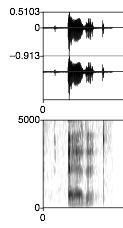 | ||||||
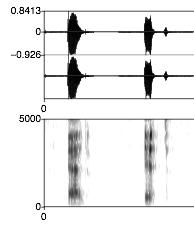 | ||||||
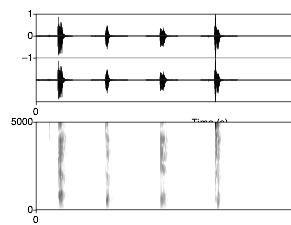 | ||||||
The approximate letter sounds /d/ /u/ /t/ /y/ | ||||||
The word duty | ||||||
The syllable du, then the syllable ty | ||||||
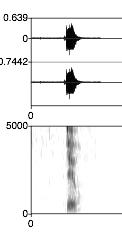 | 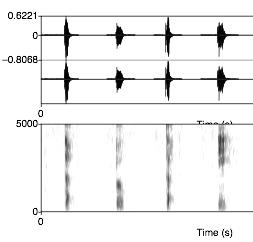 | |||||
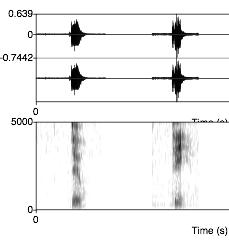 | ||||||
The Pascal letter names (letter sound approximations) /d/ /u/ /t/ /y/ are much closer to the syllable sounds of du and ty than the Pascal letter names /e/ /d/ /i/ /t/ are to the syllable sounds of ed and it. For students having trouble blending sounds together to make words, it may be better to start with the long vowel sounds (Webster's ba, be, bi, bo, bu, by, and words like me, hi, go, my) and then move on to blending short vowel sounds only after the long vowel sounds and the concept of blending are learned completely. 40L volunteers have found that "overlearning" of basic concepts is especially helpful for struggling remedial students. When teaching blending, it is best to not use letter names at all, but to only focus on letter sounds. In the case of long vowels, the sound and the name are the same--another reason to start with long vowels, as there is no possibility of confusing the letter sound with the letter name in this case! However, when moving on to short vowel sounds, be sure to always use the sound of the letter and never its name. For consonants, their approximate letter sounds should be used, not their names. Avoiding confusions in teaching reading Dr. Hilde L. Mosse explains some other types of confusions that are important to avoid. Avoiding these confusions is especially important for dyslexic students: Some textbooks such as Teaching Reading with Words in Color and some self-teaching devices use different colors for different letters or indicate the different letter sounds with different colors, so that each letter contains two signals: its form and its color (Gattegno, 1968). This confuses children to such an extent that either no conditioning takes place at all or the child becomes conditioned to only one of the stimuli, the form or the color. Pavlov has demonstrated this phenomenon in many experiments. The vast majority of children will become conditioned to the color only, because color excites children more than form. These children then read all red letters, for example, as "S," if "S" was shown read. I have observed such errors in conditioning and witnessed children struggling to disentangle form from color. Pictures are another form of interference that renders impossible the formation of these basic reflexes. The child must see the signal clearly for what is is: a form and not a picture. Where he is shown "flash cards" with a picture above a word--that is, a word and a picture shown at the same time, the necessary conditioning the child needs for reading cannot take place at all. This is the main reason the word/picture method of teaching reading to beginners is so devastating, and why comic books that train the child to picture gazing and to relying on pictures to tell stories are so damaging for reading (Mosse, 1962b). The sounds of letters and of letter combinations should be pronounced clearly and should always should always sound the same. Noises interfere with the formation of this part of the conditioned reflex. Conditioning should ideally be done in a quiet room without yelling. This is very difficult to achieve in a crowded classroom. Teachers and parents, however, should be made aware of the fact that conditioning cannot be accomplished while the television set is going, and the radio and/or the record player are blaring. [21] Training the brain to read the right way from the start 40L volunteers have seen the damage done through the teaching of sight words and the time it takes to undo the guessing habits that sight words produce. It is best to train the brain right the first time, and start your child off right--teach phonics with no sight words. Dr. Hilde L. Mosse has also found this from her research: To show a child a group of letters and to tell him that this means "house"--as is done in those kindergartens and first grades where children are introduced to reading with so-called "sight words"--confuses them, interferes with the formation of conditioned reflexes, and teaches them a lie. The letter sequence h o u s e stands for the word "house" and not for the house they see; pictures do that, but not letters. To achieve conditioning with the greatest possible speed and accuracy the child must know exactly, step by step, what he has to learn. He must be told, for instance, that the letter "S" stands for the sound "S" and nothing else, and that he must learn to say "S" when he sees "S." Whether single letters or a fixed combination of letters forming one single sound are taught, the conditioning process is the same. The child must be helped to form an automatic association between the seen letters and the spoken letters. The formation of such an association is the key to reading (Schmitt, 1966.) The formation of such a conditioned reflex requires that the child experience the visual and the spoken letter together repeatedly, without interference by any other stimulus, and always in the same sequence, namely by looking at the letter briefly before saying it. The teacher should make certain that the child is looking at the letter while the teacher sounds it and the child repeats it, or later on when the child reads it on his own. The teacher's pronunciation must act as the child's feedback correction until his own feedback system is working. That is why it is so important to let the child read aloud at first and to correct his pronunciation right away. It takes time for a conditioned reflex to be established, and it can not possibly function until the child has developed reliable visual and acoustic images and formed a close connection between them. Silent reading cannot achieve this. [22] Teaching your student to write as neatly as possible for their age helps them remember each letter's shape and learn it in a physical way instead of just the visual learning of reading. This also helps reinforce the shape and sound of each letter in the brain as they actively write the letters. Dr. Mosse also advocates writing as part of phonics training: The best way to teach this skill is by having the child write the letters and make the sounds as he writes them. Writing fixes the forms of the letters faster and more firmly in the child's mind than reading because it combines the senses of vision and touch with motor, kinesthetic, and proprioceptive (arising from striped muscles, tendons, joints) sensations. Simultaneous writing and speaking fixes the visual and the acoustic images of the letters more firmly in the child's mind than any other method, strengthens the connection between them better, and forces the child into the correct left-to-right sequence from the very start. No other teaching technique establishes the necessary conditioned reflexes with greater speed, accuracy, and reliability. Another reason reading is best taught through writing is that the reading feedback is exactly what the child must do when writing--namely, proceed from his own sounding of the letter via the engram complex to the visual signal (i.e., the letter), so that he can write it down. With dictation he has to proceed from someone else's sounding of the letter, and when he writes spontaneously, he has to start from his own acoustic memory image of it. All this strengthens the entire reflex. For this reason, the beginning reader should not be permitted to write something he cannot read or to read something he cannot write, and should always say, or at least articulate, the letters and words while he writes them down. The current practice of silent copying from the blackboard violates these principles. [23] Specific Remediation Hints 40L recommends "The Complete Handbook of Children's Reading Disorders" by Dr. Hilde L. Mosse for anyone with a dyslexic student. For each type of reading disorder, she includes explanations of the problem and also helpful tips and techniques for treatment. In her example of treatment of Linear Dyslexia with a cover card, she talks about how the use of a card below the line, while often used, is actually not the best method of treatment. Instead, she explains: A folded piece of paper or, much better, an unlined card should be held above the line the child is reading, not beneath it. This is the so-called Cover Card Method of treating Linear Dyslexia. The reason for this position of the card is that it can steady the eyes, which have a tendency to wander above and not below the line being read, and it can connect the end of one line with the beginning of the next, thus indicating the return sweep and making it easier on the child's eyes. By blotting out all the text that has just been read, the cover card helps the child to concentrate on just that one line he is reading. By holding the card at a slant with the left corner slightly lower than the right, and by pushing it down while he reads, the child steadies his gaze and at the same time pushes his eyes from left to right and down via a correct return sweep from one line to the next. This is by far the simplest, cheapest, and most effective treatment for Linear Dyslexia. [24] For problems confusing b and d, there are specific remediation exercises developed by 40L that have helped many students. Slow and steady progress wins the race. Richard G. Parker found the same was true for teaching reading in 1851. Dr. Hilde L. Mosse also agrees, and explains how not doing this can cause linear dyslexia: The child must learn linear reading from the very beginning. He must be taught to sound the letters carefully, one after the other, from left to right, and not to skip a letter or a line. This slows reading at first, but is absolutely essential for the fixation of the required conditioned reflexes and for their combination with eye movements. Special fiber tracts connect the eye muscles, which moves the eyes, with the organ of hearing in the inner ear. This makes it possible to look at the source of a sound with great speed. It also facilitates the connection of eye movements with reading (House, Pansky, & Siegel, 1979, p.194). Reversal of letter sounds within words and reversal of entire words is frequently due to defective linear reading. [25] Spelling and Dyslexia The phonetic teaching of spelling can also be helpful for teaching reading. Spelling and reading are opposite sides of the same coin. Reading involves converting symbols into sounds and spelling involves converting sounds into symbols. As Paul Hanna explains in his book Spelling: Structure and Strategies, But spelling involves more than sensory memories and motor responses. The ability to spell is also related to the development of the concepts about orthography--i.e. how the writing systems reflects, or fails to reflect, speech--so that phoneme-grapheme [sound-symbol] relationships can be grasped. [26] A recent study found that dyslexics that were taught spelling in this orthographic manner improved their spelling. The study also found that this type of teaching "can actually change their brains' activity patterns to better resemble the brains of normal spellers." [24] An easy to use orthographically arranged spelling program is "Spelling Plus" by Susan C. Anthony. Another resourse that teaches spelling in this manner and provides a companion spelling notebook for students to write and categorize words they misspell is Gayle Graham's Spelling Program. Free online alternatives are The American Spelling Book or, for beginning students, Easy Steps in Spelling. True Dyslexia Students with true organic dyslexia may need to use an Orton-Gillingham (OG) program. Recipe for Reading by Traub and Bloom is an inexpensive manual containing everything you need to make your own OG program. You just need a white board and a marker to write out the words from their word lists. The workbooks can save time, but they are not necessary. Recipe for Reading is also an easy way to customize OG teaching and move at the pace of the student. It can usually be completed within a year. For upper level work as a follow on, there is Sopris West Rewards, it is well designed and also moves very fast. Most other OG programs are not as easy to adapt and take several years to complete. There are many good OG programs available. The easiest to use on your own is Barton Reading. It is expensive, but less expensive than OG tutoring. Another popular OG program is Wilson Reading. You can also print out a free basic OG program thanks to the M. A. Rooney foundation, links to the curriculum can be found in a post by Tatyana Elleseff of Smart Speech Therapy, the post also has other literacy resources. Final Thoughts The use of UPP (a diacritically marked version of English with a 1-to-1 sound to symbol correspondence) may also be helpful for students with dyslexia. Nonsense words are also helpful. The best phonics method for dyslexics is Webster's The American Spelling Book. Webster's Speller teaches through syllables, the true atoms of reading instruction, and reinforces this teaching through the repeated writing and spelling of syllables. However, other well-designed phonics programs can also work, as long as you do not teach sight words and keep your focus on sounding out every letter from left to right. 40L volunteers have successfully taught many dyslexic students with the free online phonics lessons, and have also had success with Phonics Pathways. Don Potter has had success teaching dyslexics with Phonics Pathways, Blend Phonics (free online) followed by his Blend Phonics Reader, and the exercises in the back of Flesh's Why Johnny Can't Read. All of these methods use synthetic phonics with no stories, so there is no opportunity for context guessing. 40L's online lessons, Toe-by-Toe, and We All Can Read also all use nonsense words. Nonsense words eliminate the possibility of guessing because there is no way to guess a nonsense word! 40L's free online phonics concentration game also uses a combination of real and nonsense words. Reading nonsense words helps keep the student focused on sounding out each word from left to right. 40L's remedial students progress the fastest when outside reading is limited or eliminated during the beginning of remediation. An average sentence contains 50% of the words as sight words, and these sight words and the context of the sentences may trigger the guessing reflex. Intensive focus on individual words with phonics is important to switch your brain from its guessing habits to good left to right sounding out habits. Remember, slow and steady wins the race. Good luck retraining your brain with phonics! 1. Dyslexia. (n.d.). Dictionary.com Unabridged (v 1.1). Retrieved August 03, 2007, from Dictionary.com website: http://dictionary.reference.com/browse/dyslexia 2. Mosse, Hilde L, M.D., "The Complete Handbook of Children's Reading Disorders," 1982. Vol I, p. 83 - 84, 137 - 139. 3. Dehaene, Stanislas, "The Massive Impact of Literacy on the Brain and its Consequences for Education," Human Neuroplasticity and Education, 2011, p. 23 [Note: Stanislas Dehaene's 2009 book "Reading in the Brain" has a more detailed explanations and compares many different studies.] 4. Lyon, G. Reid, Ph.D., "Reading Disabilities: Why Do Some Children Have Difficulty Learning to Read? What Can Be Done About It?," Education News, 29 March 2003, available online at http://www.wrightslaw.com/info/read.disability.lyon.pdf 5. Rodgers, Geraldine E., "The Case For the Prosecution," 2006. p. 69 6. Mosse, Hilde L, M.D., "The Complete Handbook of Children's Reading Disorders," 1982. Vol I, p. 49 7. Mosse, Hilde L, M.D., "The Complete Handbook of Children's Reading Disorders," 1982. Vol I, p. 85 8. Mosse, Hilde L, M.D., "The Complete Handbook of Children's Reading Disorders," 1982. Vol I, p. 132 9. Mosse, Hilde L, M.D., "The Complete Handbook of Children's Reading Disorders," 1982. Vol I, p. 137 10. Dehaene, Stanislas, "Reading in the Brain," 2009. p. 201 11. Dehaene, Statislas, "Illiterate to Literate:behavioural and cerebral changes induced by reading acquisition," Nat Rev Neurosci, 16(4):234--244, April 2015. 12. "Adults With Dyslexia Can Improve With Phonics-based Instruction, Research Shows," Science Daily, October 24, 2004. Available online at: http://www.sciencedaily.com/releases/2004/10/041027144140.htm 13. Fletcher, Jack M, Ph.D, "Reading and Response to Intervention: Enhancing Outcomes for all Students," online presentation, 2008. Slide titled "Intervention Normalizes Brain Function" showing the brain before and after phonics tutoring is especially interesting. 14. Note: Spelling Books in the 1700's and early 1800's were used for both phonics and spelling purposes, and were used to teach children to read. Noah Webster himself explains this in his 1828 American Dictionary of the English Language. The entry for spelling-book reads, "n. A book for teaching children to spell and read." 15. Rodgers, Geraldine E., "The Case For the Prosecution," 2006. p. 239 16. Rodgers, Geraldine E., "The Case For the Prosecution," 2006. p. 240 17. Rodgers, Geraldine E., "The Case For the Prosecution," 2006. p. 241 18. Rodgers, Geraldine E., "The Case For the Prosecution," 2006. p. 243 19. Rodgers, Geraldine E., "The Case For the Prosecution," 2006. p. 250 20. Rodgers, Geraldine E., "The Case For the Prosecution," 2006. p. 251 21. Mosse, Hilde L, M.D., "The Complete Handbook of Children's Reading Disorders," 1982. Vol I, p. 87 22. Mosse, Hilde L, M.D., "The Complete Handbook of Children's Reading Disorders," 1982. Vol I, p. 81 23. Mosse, Hilde L, M.D., "The Complete Handbook of Children's Reading Disorders," 1982. Vol I, p. 81 - 82 24. Mosse, Hilde L, M.D., "The Complete Handbook of Children's Reading Disorders," 1982. Vol I, p. 130 25. Mosse, Hilde L, M.D., "The Complete Handbook of Children's Reading Disorders," 1982. Vol I, p. 83 26. Hanna, Paul R, Richard E. Hodges, and Jean S. Hanna, "Spelling: Structure and Strategies," 1971. p. 104. 27. Dahms, Joel, "Spelling out Dyslexia," Northwest Science & Technology, Fall 2006 | |